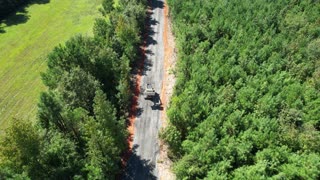Premium Only Content

Fluoride Spill In Illinois Eats Concrete In Driveway - Hydrofluorosilicic Acid is the real name
Once Hydrofluorosilicic Acid that's collected from phosphate Fertilizer Industrial Plants is added to our city drinking water in USA they change the name to fluoride... Fluoride is just a generic term to hide what the government is really adding to our water. - Fluoride will cause a lifetime of sickness, cancer and early death. Do you want proof?
For more information contact the Safe Water Foundation, 6439 Taggart Road, Delaware, Ohio 43015 and check out www.flouridealert.com.
Fluoride eats through concrete & steel but it's safe to swallow says the "Government Paid Scientist experts"
How do freemason controlled puppet governments? - They compartmentalize everything so the left hand doesn't know what the right hand is doing... GOVT'S Divide everyone and everything so we the people fight each other and not the real hidden Bankers, Freemason, Fake Jesuits, The Vatican, Other fake religions controlled by Freemason Councils with Section 501 (c) (3) is the portion of the US Internal Revenue Code that allows for federal tax exemption of nonprofit organizations... And government kickbacks.
Don't go to any church or organization that signs their soul away with Govt Section 501 (c) (3) that allows for federal tax exemption - Government also give kick back under the table.
This is what the federal government adds to your city drinking water and many food/drink products, gee isn't that wonderful. Now your know why so many children have cancer, fluoride is the number one cause of cancer.
CHEMICAL DATA NOTEBOOK SERIES #98: HYDROFLUOROSILICIC ACID
Hydrofluorosilicic acid is a corrosive, reactive, irritating, colorless to light yellow fuming liquid with a sour, acrid odor. It is used as a cement and ceramic hardener, a fluoridation agent for drinking water, a wood preservative, and a raw material for making paints. It is used also in the manufacture of aluminum fluoride, cryolite, hydrogen fluoride and for sterilizing bottling and brewing equipment.
Hydrofluorosilicic acid is nonflammable and has the following properties: specific gravity 1.3, molecular weight 144, vapor density 4.97, boiling point 212°F (at which temperature it decomposes), and freezing point -4 to -24°F. It is totally soluble in water. Its chemical formula is HiSiFf,.
HAZARDS
Hydrofluorosilicic acid is very corrosive. An inorganic acid, it is classified as a “strong” acid, as are all inorganic acids. (An acid’s strength is defined as the percentage of ionization the acid undergoes when dissolved in water: it has nothing to do with the concentration (the amount of acid dissolved in water) of the acid.] Inorganic acids are highly hazardous even at low concentrations; their degree of ionization is nearly 100 percent. Other inorganic acids include sulfuric acid, hydrochloric acid, hydrofluoric acid, chromic acid, nitric acid, and phosphoric acid (among numerous others).
Organic acids, on the other hand, are classified as weak acids since their degree of ionization in water is extremely low. often considerably less than one percent. Examples of organic acids include acetic acid (present in vinegar), formic acid (the painful substance injected by most stinging insects), lactic acid (present in sour milk), and acrylic acid, a monomer for many plastics. Again, these four organic acids are taken from a list of thousands.
The strength of an acid commonly is erroneously associated with its corrosiveness. Generally speaking, while it is true that strong acids are more corrosive than weak acids, concentrated weak acids can be very corrosive to human tissue and other materials. Do not try to classify the danger an acid poses to human tissue or other materials on the basis of its “strong” or “weak” designation. To be sure of the danger posed, you must know exactly what the acid is and its level of concentration.
If hydrofluorosilicic acid’s concentration is high enough, it will severely damage any human tissue it contacts. Pure hydrofluorosilicic acid and most concentrations of this acid in water are extremely corrosive: Even relatively low concentrations can severely damage human tissue. The damage can range from simple first-degree bums to very deep, tissue-destroying third-degree burns. Chemical burns are always many times more severe than thermal burns, so severe harm (to the point of causing death) can occur with relatively small areas of tissue damage. Eyes and skin will be severely damaged by contact with concentrated hydrofluorosilicic acid fumes or vapors; the hazards are more far-reaching than those posed by contact with the liquid. If very low concentrations of the acid contact the skin, the damage may be as light and simple as reversible irritation of the tissue involved.
Inhaling the vapors or fumes will severely damage the mouth, nose, and the entire respiratory system. Such damage could cause pulmonary edema, which could lead to death. At the very least, respiratory tissue could be permanently damaged, resulting in lifelong breathing impairment.
Ingesting hydrofluorosilicic acid will damage the lips, mouth, esophagus, and stomach. The degree of damage would depend on the concentration of the acid.
Hydrofluorosilicic acid is also corrosive to plant tissue, and most contacts of the acid with plant tissue usually will result in the death of that tissue and the plant to which it belongs. Because of this, hydrofluorosilicic acid is very’ dangerous to the environment, and its free movement in that environment must be controlled.
Most metals will be rapidly destroyed by the chemical corrosion caused by contact with hydrofluorosilicic acid. The metal will fail, which will be very dangerous if it is in any engineering component or used in the container’s construction. The rate of corrosion would depend on the type of metal, the duration of exposure, and the concentration of the acid; the rate of failure of the material would depend on the concentration of the acid and the thickness of the metal at the point of contact.
An additional hazard posed by hydrofluorosilicic acid and other acids is that the chemical action of the acid on metal usually releases hydrogen, a very explosive gas (see Fire Engineering, November 1993). The amount of hydrogen released and the rate of release would depend on the type of metal, the concentration of the acid, and the amount of metal exposed to the acid. In some cases, the energy generated by the chemical reaction of the acid and the metal could be sufficient to ignite the gas. The size and severity of the resulting explosion, naturally, would depend on the amount of hydrogen evolved and its concentration in the air surrounding the ignition source. Although hydrofluorosilicic acid is nonflammable, the action that produces hydrogen gas makes it very hazardous when near or involved in a fire.
An additional hazard of hydrofluorosilicic acid (and other acids containing fluorine) is the generation of hydrogen fluoride (see Fire Engineering, May 1988). This very corrosive halogen acid gas usually evolves during a fire involving materials containing fluorine in their chemical makeup, and not during normal corrosive reactions. However, hydrogen fluoride is extremely corrosive, and all emergency responders should take the steps necessary to protect themselves from it.
https://www.fireengineering.com/leadership/chemical-data-notebook-series-98-hydrofluorosilicic-acid/
-
 38:41
38:41
Knowledge They Don't Want You To Know
5 months agoTimeline Begins in 1800? - Pt 1 & 2
2.25K -
 2:58
2:58
🇺🇸 Make Concrete Great Again
4 years agoStain and Seal Concrete Driveway
84 -
 0:30
0:30
chrisholmes
3 years agoNew Driveway
41 -
 7:45
7:45
smronly
3 years agoReinforced Concrete Design - Reinforced Concrete Structure 1.2
29 -
 1:15
1:15
DowagerLadyUrsula
3 years agoIllinois Prairie Sunset
53 -
 1:25
1:25
chrisholmes
3 years ago $0.01 earnedDriveway
571 -
 17:21
17:21
Projects Around with Dave and Ray
3 years agoConcrete Cutting
271 -
 0:18
0:18
PaineExcavatingLLC
3 years agoConcrete cutting saw
110 -
 0:25
0:25
Falcon1115
3 years agoCrushing Concrete
53 -
 2:48
2:48
smronly
3 years agoReinforced Concrete Design - Properties of Reinforced Concrete 1.1
56